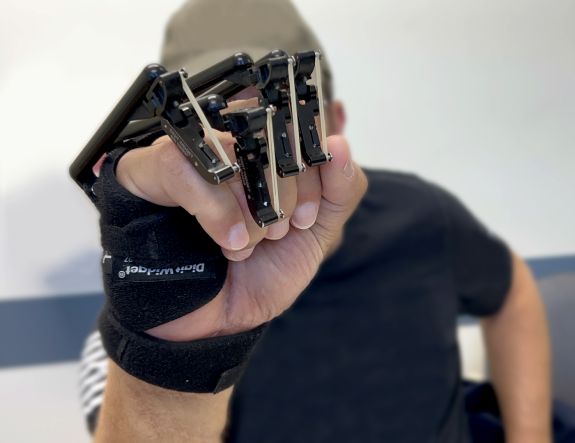Have you heard of the Digit Widget?
The name may be cute, but the Digit Widget is a proven device to help reverse severe PIP flexion contractures. More than 17,000 Digit Widgets have been installed since 2002.
We often hear from patients who were told the only options for their severe contracture were amputation or just live with it. Fortunately, they didn’t give up and they found a surgeon who suggested the Digit Widget as part of their treatment plan.
What it does
With conventional splints it is difficult to apply an effective torque without causing pain and inflammation due to pressure on the skin. Since Digit Widget transmits torque directly to the skeleton, there is no pressure on the skin to cause discomfort. The skin, blood vessels, nerves and supporting joint structures should respond to this torque by lengthening and reversing the flexion contracture. With length restored to the palmar soft tissues, surgical access is easier and scarring is reduced.
How it works
The Digit Widget is surgically installed on the finger with two small bone pins. A soft cuff wraps around the hand to provide an anchor for the force that straightens the finger over time. After surgery, an elastic band is attached to the device creating a gentle extension force.
One part of an overall approach
Although it can improve extension, the Digit Widget is typically a step in an overall treatment plan to restore force balance across the joint. For Dupuytren, this may include fasciectomy, needle aponeurotomy, or some other approach to deal with the diseased tissue. In trauma cases, a pulley repair, tenolysis, central slip repair, or other correction may be required to address the force imbalance. Your surgeon will determine the cause of the force imbalance and the method for restoring balance across that joint.
Treatment duration
These changes don’t happen overnight. Just as it takes time for teeth to move in orthodontia, it takes time to reverse a long-standing joint contracture. A gain of 5-10 degrees of joint extension per week may be expected. If you have a severe contracture, you may be wearing the Digit Widget for many weeks, possibly even several months. For joint extension to be maintained following device removal, your surgeon must formulate a treatment plan to address the issues that are unique to your flexed finger. This plan may involve additional surgery. Even with optimal analysis of, and surgery for, the cause of your contracture, patients may experience recurrent finger deformity.

Two or more Digit Widgets can be installed at one time


Is Digit Widget right for you?
The Digit Widget will help to gain extension for most contractures. The device should not be used for PIP joint contractures on patients with either osteoarthritis or post traumatic joints with residual joint incongruity. Successful reversal of a PIP joint contracture requires a joint surface that is anatomically intact.
Patient cooperation and participation are important to effective Digit Widget use. Digit Widget patients must be able to follow the postoperative regimen. This includes:
- Changing elastic bands daily (bands contain natural rubber latex; patients with latex sensitivity may call to request latex-free bands)
- Performing flexion and extension exercises as instructed by the surgeon or hand therapist
- Avoiding activities that may cause the device to be excessively bumped or tugged (such as by a child or pet)
- Good hygiene to keep the pin sites clean and dry
- Reporting adverse or unanticipated events to your surgeon
We’ve worked hard to make the Digit Widget a patient and surgeon-friendly tool to aid in the treatment of PIP flexion contractures. We know that having surgery is a serious matter and we will provide as much information as we can to help in your decision-making process.
Questions To Ask Your Surgeon
Is the Digit Widget right for me?
Do we know what is causing the force imbalance?
Will I need additional surgery?
For how long will I wear the Digit Widget?
Will I need to wear a splint once the Digit Widget is removed?
What information do you want to see?
Please share feedback if you feel we’ve missed something, or if there is specific information you’re looking for. We would love your feedback!
- Any features you feel are missing?
- What additional information are you looking for?
- How would you like to learn more about the Digit Widget?

